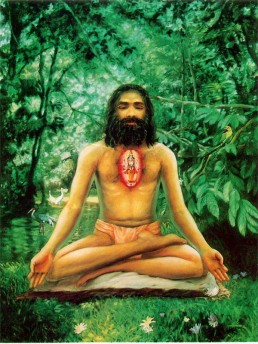Swami Chinmayananda Commentary
After thus describing the physical pose, the mental stability and the consequent intellectual self-application, the Lord now describes the last lap in the technique of meditation to His beloved friend, the Pandava Prince. When all the above details are worked out by anyone, that individual becomes a man steadfast both in his physical and in his subtler life, and thereby, he comes to release from himself a large quantity of his psychic vitality. In this stanza it is said that, when a meditator controls his mind and ‘constantly’ (Sada) keeps his mind away from its agitations, he can easily and surely reach the Supreme.
The term ‘always’ (Sada) should not be misunderstood as suggesting that the practitioner should live, criminally neglecting all his duties towards his home and the world around himself. Here the term ‘always’ only connotes “a duration of constant and consistent inner silence,” during one’s meditation. At the peak of meditation, the practitioner comes to a point of perfect ‘halt’.
The individual comes to experience infinite peace which is “the peace that resides in him.” The Self is Peace Absolute (Shantam), inasmuch as the processes of physical excitements, mental agitations and intellectual disturbances are not in the Self, It being beyond these matter-envelopments. Here it may look as though Krishna is advocating the dualistic school of philosophy, since it is said: “The meditator reaches the peace that is My own nature.” To conceive of a Truth having qualities, is to reduce the Eternal to the finite status of a substance (dravya). Again, if the meditator experiences “THE PEACE THAT RESIDES IN ME,” then the goal gained becomes an ‘object’ apart from the meditator.
The subtle philosopher, Sri Krishna, recognises this unavoidable imperfection of the spoken language, and therefore, he tries to neutralize the fallacy in his expressions by the significant terms “the Peace, that ultimately culminates in the Supreme liberation” (Nirvana-paramam).
In short, when the meditator has come to the moment of perfect silence within, he comes to experience, at first, a peace that is unknown in the world without. Soon, as it were, the experiencer gets slowly acted upon and digested into the very substance of the Truth, whose fragrance was the Peace, which the dying ego of the meditator seemed to experience at the gateway of its own Real Divine Nature. In fact in the last stage of fulfilment in meditation, the meditator ‘awakens’ to his status of Self-hood. This Advaita experience is the one fact that has been repeated and emphasised all through Krishna’s Song Divine.
FOLLOWING ARE THE REGULATIONS, AS REGARDS THE MEDITATOR’S FOOD, ETC:
Adi Sankara Commentary
Yunjan, concentrating; atmanam, the mind; evam, thus, according to the methods shown above; sada, for ever; the yogi, niyata-manasah, of controlled mind; adhi-gacchati, achieves; santim, the Peace, the indifference to worldly attachments and possessions; nirvana-paramam, which culminates in Liberation; and mat-samstham, which abides in Me. Now are bieng mentioned the rules about the yogi’s food etc.:
The Bhagavad Gita with the commentary of Sri Sankaracharya – Translated by Alladi Mahadeva Sastry
Holy Geeta – Commentary by Swami Chinmayananda
The Bhagavad Gita by Eknath Easwaran – Best selling translation of the Bhagavad Gita
The Bhagavad Gita – Translation and Commentary by Swami Sivananda
Bhagavad Gita – Translation and Commentary by Bhaktivedanta Swami Prabupadha
Srimad Bhagavad Gita Chapter 6 – Verse 15 – 6.15 yunjannevam sadatmanam – All Bhagavad Gita (Geeta) Verses in Sanskrit, English, Transliteration, Word Meaning, Translation, Audio, Shankara Bhashya, Adi Sankaracharya Commentary and Links to Videos by Swami Chinmayananda and others – 6-15

